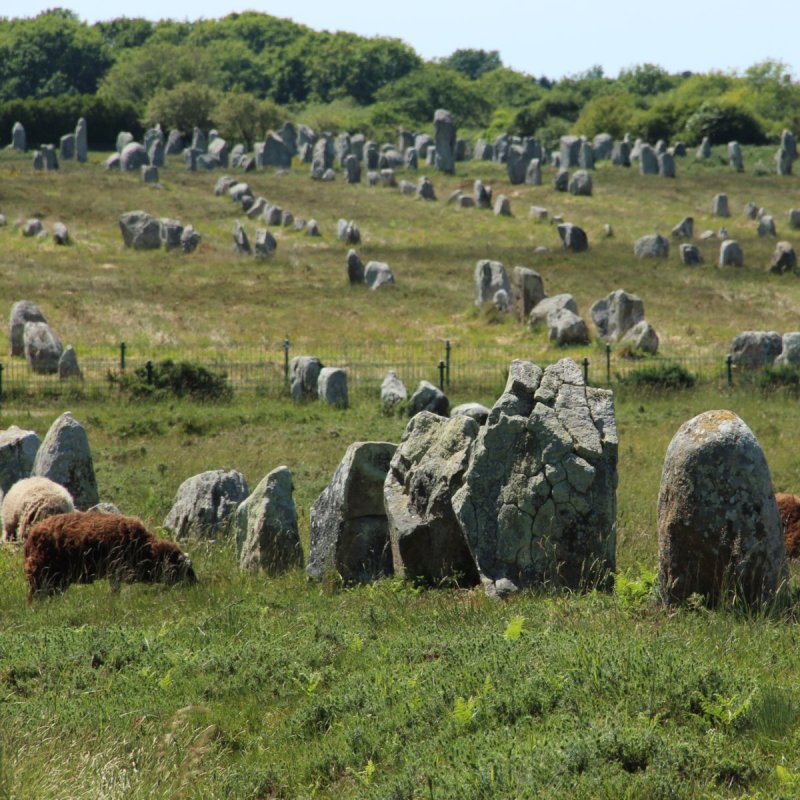
You can see a photograph of standing stones in a megalithic site, but the experience is quite different standing among towering stones or ones that stretch as far as the eye can see.
Videos by TravelAwaits
Most people have heard of Stonehenge in Salisbury, England, where gigantic stones reach for the sky, and immense rocks are perched atop others. I, for one, have stood in their presence and witnessed the Druid ceremony on the summer solstice. Perhaps that is the root of my fascination with megalithic standing stones. Therefore, I knew when I was near Carnac, France, that I had some investigating to do.
Not too many people have heard of the Carnac Alignments in France, but they are the largest collection of megalithic standing stones in the world. Your imagination can only go into high gear stepping onto the uneven field with scads of various-sized stones stretching out before you.
Visiting the Carnac Stones is, in my opinion, an awe-inspiring and magical experience.

What Are The Carnac Standing Stones?
The Carnac Stones in France are a megalithic complex consisting of 3,000 standing stones spread over 100 acres that stretches 2.5 miles wide. According to archaeologists, the stones are from the Neolithic Period and have been in place since 3500 BCE. Some believe that the Carnac Stones have been there since 4500 BCE. Unlike other megalithic sites where the rocks were moved great distances, the stones at Carnac were cut from local granite and erected by the pre-Celtic people of Brittany.
Most notable at Carnac are the extraordinary alignments, long rows of parallel lines of standing stones. Keep your eyes open for menhirs, single-standing stones, and tumuli, which are burial mounds. Dolmens, another formation of prehistoric stones, are easily recognized. Look for two upright rocks topped by a capstone marking the ancient tomb.
Where Are The Carnac Alignments Found?
The Carnac Alignments, classified as a historic monument since 1889, are found near the town of Carnac in Brittany, France. The Carnac Alignments are made up of two main sites, Menec and Kermario. It is best to start at Menec, where the visitor center is located.

Why Are The Carnac Stones Mysterious?
There have been many theories over the centuries explaining the existence of the Carnac Stones. Perhaps they were an ancient burial site or a religious gathering place. Did the Carnac Stones act as astronomical markers indicating the seasons and guiding farmers when to plant and harvest? Was this megalithic site used for observations of the moon? Were the Carnac Stones linked in some mysterious way to the nearby megalithic site at Loqmariaquer?
Several wild legends explain the existence of the Carnac Alignments. One recounts a tale of the wizard Merlin who, as a Roman army invaded, turned every soldier into stone.
The most recent theory shared at the visitor center explains that the Neolithic people were becoming more sedentary and the stones led to sacred enclosures.
The Carnac Stones Today
Over the centuries, some of the standing stones at Carnac have been removed or used for other purposes. Some were quarried. Others were moved to make room for roads. Stones were placed in new positions. Unfortunately, this has disturbed the original formation and possibly removed clues about the stones’ original purpose.
Since 1991, the Carnac Stones have had a fence around them to protect them from graffiti, being toppled, and the large number of visitors the site receives each year.

How To Visit The Carnac Standing Stones
The best way to get to the Carnac Alignments is by car. Driving directions are found here.
From October until the end of March, entrance to the Carnac Stones is free and unaccompanied visits are allowed.
From April to September, the fence is closed, and one can only walk amidst the stones as part of an organized tour. It is important to make a reservation for your 1-hour tour in advance. Book your tour here.
During peak season, there are also guided tours on a little train and an open-air bus that covers the expansive area of the Carnac Alignments.
The Maison des Megaliths is the visitor center on-site. It includes an interpretative area, a gift shop, and a terrace with a panoramic view overlooking the Carnac Standing Stones.
Pro Tip: The field of standing stones is very uneven, so be sure to wear sturdy shoes. In peak season, go early in the morning to beat the crowds.

Further Afield For Standing Stone Enthusiasts
If you are looking for more information about the standing stones and local artifacts from over the centuries, visit The Carnac Prehistory Museum located in the town of Carnac.
This area of Brittany has many smaller but just as fascinating standing stone sites. Here are a few to keep in mind: Cairn of Barnenez, Cairn of Gavrinis, Cairn of Petit Mont (seen above), the Dolmens of Mane-Bras, and the Dolmen of Penhap on nearby Ile aux Moines.
Related Reading:
